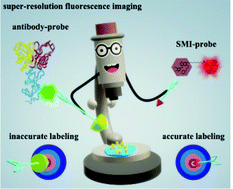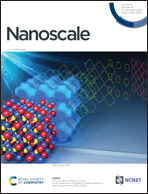Development of small molecule inhibitor-based fluorescent probes for highly specific super-resolution imaging†
Abstract
To ensure the ultimate high-quality imaging of super-resolution fluorescence microscopy with increasingly high resolution, it is significant to use small specific fluorescent probes. Compared with the common biological fluorescent labeling technology, because of small size, strong specificity, abundance and special binding sites, single-targeted small-molecule inhibitors (SMIs) can link with organic dyes to form small fluorescent probes for various biomolecules. Herein, to confirm the feasibility of the SMI-probes, epidermal growth factor (EGF) receptor (EGFR)-targeted tyrosine kinase inhibitor Gefitinib was selected for modification with the fluorescent dye to form Gefitinib-probe. Then, the labeling superiority of Gefitinib-probe was revealed by comparing the direct stochastic optical reconstruction microscopy (dSTORM) images of EGFR labeled with different probes. Additionally, a high co-localization of fluorescent points from Gefitinib-probe and EGF-probe labeling indicated a high specificity of Gefitinib-probe to EGFR. Finally, higher co-localization of EGFR and HER3 labeled with the probe pair containing Gefitinib-probe than with the antibody-probe pair suggested that Gefitinib-probe with a cytoplasmic binding site benefited dual-color imaging. These results indicate that the SMI-probes are able to serve as versatile labeling tools for high-quality super-resolution imaging.



 Please wait while we load your content...
Please wait while we load your content...